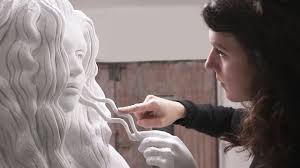
Stone sculpture is one of the oldest and most respected forms of art. From ancient monuments to modern masterpieces, stone has been shaped by human hands to tell stories, honor history, and beautify spaces. Today, with advancements in tools and techniques, custom sculpture services have transformed how stone sculptures are created—combining traditional methods with cutting-edge technology to deliver personalized and professional results.
In this guide, we’ll explore how stone sculptures are made, and how custom sculpture and custom stone sculpture services play a vital role in the creative and manufacturing process.
Understanding the Art of Stone Sculpture
Stone sculpture is the art of shaping natural stone into a three-dimensional form. Artists use various techniques such as carving, chiseling, and polishing to bring out details and create expressive works. Common types of stone used include:
- Marble: Known for its softness and beauty; often used for fine art.
- Granite: Hard and durable; great for outdoor sculptures.
- Limestone: Easier to carve and ideal for architectural elements.
- Sandstone and Soapstone: Soft and suitable for detailed work.
Each type of stone has its own texture, hardness, and aesthetic qualities, which influence how the sculpture is designed and made.
What Is Custom Sculpture?
Custom sculpture refers to sculptures created based on specific ideas, dimensions, or themes requested by a client. These sculptures are often designed for:
- Private collections
- Corporate installations
- Memorials
- Religious and spiritual artworks
- Public monuments
- Decorative landscaping
Custom sculpture is a collaborative process between the artist (or studio) and the client to turn a vision into a physical, tangible form—often from materials like stone, metal, fiberglass, or resin.
What Is Custom Stone Sculpture?
A custom stone sculpture specifically focuses on using natural stone to create bespoke artworks. Unlike mass-produced decorative items, custom stone sculptures are hand-carved or machine-assisted and are made to match unique themes, styles, and locations.
From classical busts to modern abstracts, every piece is tailored for visual impact and built to last generations.
Step-by-Step: How Stone Sculptures Are Made
Creating a stone sculpture—especially a custom one—is a detailed process involving both creativity and craftsmanship. Let’s look at each stage of production:
1. Concept and Design
The process begins with a conceptual idea. For custom sculptures, this usually involves a consultation between the client and the artist or sculptor. The client may provide:
- A sketch or photo
- Dimensions
- Preferred style (classical, modern, abstract, etc.)
- The type of stone desired
Artists may also create clay or 3D digital models to help visualize the final piece.
Custom sculpture studios often use software like CAD (Computer-Aided Design) to develop precise models that can be approved by the client before work begins.
2. Stone Selection
The type of stone is critical to the project. Artists consider color, grain, hardness, and workability when choosing the right material. For custom stone sculptures, clients may select stone based on aesthetic appeal or durability, especially for outdoor installations.
Reputable suppliers provide high-quality stone blocks sourced from quarries around the world, with marble from Italy, granite from India, and limestone from Egypt among the most popular.
3. Rough Shaping
Once the stone is selected, the artist begins by roughing out the basic shape of the sculpture. Traditionally, this is done with a mallet and point chisel to chip away large sections of stone.
In modern custom sculpture practices, CNC machines and diamond saws may be used to assist with initial shaping. These machines follow the digital model to remove bulk material quickly and accurately.
However, the final shaping is almost always done by hand to achieve the required detail and artistry.
4. Carving and Detailing
This is where the real artistry takes place. Using fine chisels, rasps, and rifflers, the sculptor gradually carves out the intricate details of the design. Depending on the complexity, this stage can take weeks or even months.
For custom stone sculptures, attention to detail is critical. Whether it’s the folds of fabric in a statue or the facial expression on a bust, every curve and line must be carefully refined.
In some modern studios, laser-guided tools and precision hand tools help enhance detailing without losing the handcrafted essence.
5. Sanding and Polishing
Once the carving is complete, the surface of the sculpture is sanded to remove tool marks and prepare it for finishing. This involves several stages:
- Coarse sanding to shape
- Medium sanding to refine
- Fine sanding for smoothness
For highly polished stone sculptures, polishing compounds and buffing wheels are used to create a glossy surface. Matte finishes are achieved by sandblasting or leaving the surface slightly textured.
Custom sculptures are finished based on client preference—whether glossy, satin, or natural.
6. Mounting and Installation
For larger or public pieces, the sculpture is mounted on a base, often made of the same or complementary material. Mounting may include metal pins or adhesive systems to secure the sculpture safely.
Custom stone sculptures destined for outdoor display often require sealing to protect against weathering, moisture, and UV damage.
Installation may be handled by the sculpture studio or a dedicated team, depending on the project’s scale and location.
The Role of Custom Sculpture Studios
Custom sculpture studios bring expertise, tools, and infrastructure that individual artists may not have. Here’s how they support the process:
- Design assistance: Helping clients turn ideas into reality
- Material sourcing: Access to premium stone and reliable quarries
- Production facilities: Equipped with CNC routers, diamond tools, and dust extraction systems
- Skilled artisans: Experienced sculptors trained in classical and modern techniques
- Logistics and installation: Managing transport, permits, and secure installation
Studios that specialize in custom stone sculpture ensure that every piece meets the highest standards of craftsmanship, safety, and aesthetics.
Benefits of Choosing Custom Stone Sculpture
Whether for residential, commercial, or public use, custom stone sculpture offers several advantages:
- Uniqueness: Each piece is one-of-a-kind and tailored to your vision.
- Durability: Stone lasts for centuries and withstands the elements.
- Prestige: Adds value and artistic credibility to any space.
- Emotional significance: Perfect for memorials, tributes, and landmarks.
- Cultural preservation: Keeps classical techniques and stories alive.
Unlike factory-made art, custom sculptures carry the signature of both the artist and the client—making each piece personally meaningful and timeless.
Conclusion
Stone sculpture is a blend of ancient tradition and modern innovation. With the support of custom sculpture services and professional custom stone sculpture studios, artists and clients can co-create works that are visually stunning, structurally sound, and deeply symbolic.
From the first sketch to the final polish, every step is a journey of transformation—turning raw stone into art that speaks, lasts, and inspires. Whether you’re looking to create a statue for your garden, a religious monument, or a personalized art piece for your home, custom stone sculpture is an enduring way to leave a legacy in stone.
